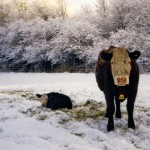Occasionally the stockman encounters a diffi cult calving situation caused by an abnormality in the fetus or dam. As stated by Dr. David Steffen, diagnostic pathologist and professor, School of Veterinary Medicine, University of Nebraska, the most common problem is discrepancy between size of the calf and pelvic area of the dam. This type of […] Read more
Abnormalities That May Impede The Birth Process
Planned Grazing
There are many facets to a well-planned grazing system. How you manage the grazing on your place will depend a lot upon your soils and climate, topography and types of pasture, and your goals Rotational short-duration (management- intensive) grazing has become well recognized as a way to increase cattle performance, pasture health and productivity. How […] Read more
A Word About Minerals
Minerals are essential nutrients. Sodium, chlorine and potassium are crucial to maintain fluid balances in the body and blood. Sodium chloride (salt) should always be provided because cattle need more salt than occurs naturally in forages. Iron is an important component of red blood cells — enabling them to carry oxygen. Bone formation and milk […] Read more
Advantages Of Multi-Species Grazing
In a natural situation, several species of animals utilize the plants in an ecosystem because they have different dietary preferences and grazing behaviour. This complementary grazing is healthiest for the land and forage, keeping the plants in ecological balance, according to Dr. Karen Launchbaugh, Professor of Rangeland Ecology at the University of Idaho. Environmental factors […] Read more
They aren’t really malpresentations; they just need a little extra help to come naturally
Sometimes a calf cannot be born because he’s not in a position that allows him to enter the birth canal. In other situations he may not be able to progress through the birth canal because he’s too large, or a limb is caught on the pelvic brim, or the head is turned back. Knowing what’s […] Read more
More often than not the cure is time and patience
The final stage of labour is shedding of placental membranes. The cow continues to have uterine contractions (often accompanied by abdominal straining for a few hours after calving) until the membranes come loose and emerge through the birth canal. The stretched uterus begins shrinking as soon as the calf is delivered, and uterine contractions may […] Read more

Tips for warming cold or frozen newborn calves
Any calf with a temperature below 37.7 C (100 F) needs assistance and warming. There are several ways to safely warm calves, and the methods you choose will generally depend on your facilities
Precautions with Hot Water The quickest way to thaw a frozen calf is with warm water, but if you use this method make sure the water is not too hot. If it’s very much above normal body temperature, it may damage the skin — which is already compromised if it’s been frostbitten. Rapid thaw at […] Read more
SEPTICEMIA IN CALVES
Occasionally a calf develops infection in which bacteria or their toxins get into the bloodstream and travel throughout the body, creating a condition called septicemia. Some toxin-forming bacteria rapidly cause death. The calf goes into shock when internal organs are damaged and start shutting down. In some instances the infection may localize, creating internal abscesses, […] Read more
The cow’s nutrition in late gestation has a lot to do with it
Calves that are chilled at birth without immediate assistance to warm/ dry them and make sure they ingest colostrum in a timely manner have poor survival rates. If a calf’s mouth gets cold before he suckles, he may not be able to get the teat in his mouth and suck, and therefore does not obtain […] Read more
ALTERNATIVE/EMERGENCY FEEDS FOR CATTLE
On dry years it can be difficult to provide adequate feed for cattle. Barry Robinson, an independent consulting nutritionist (Great Northern Livestock Consulting) in Westlock, Alta., says traditional winter feeds are hay, silage and straw, but a low-protein forage like straw needs to be balanced with a higher-protein source like alfalfa hay. “This year alfalfa […] Read more


